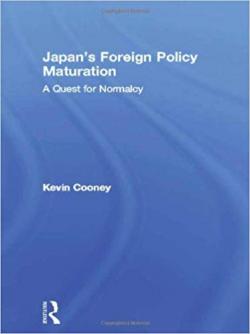Japan's Foreign Policy Maturation: A Quest for Normalcy

By Kevin J. Cooney
Routledge, (2002)
ISBN: 0415935164
Review by J. Sean Curtin
This book comprehensively charts the dynamics of Japanese foreign policy during the nineties as Tokyo struggled to cope with the end of the Cold War and the limitations of its war-renouncing constitution in the newly emerging global order. Exactly the same issues continue to fuel the current debate, making this work a highly relevant piece of analysis about the on-going phase in foreign policy evolution. The nineties will soon be a decade behind us, but Japan is still battling to find a new place on the shifting global stage while it agonizes over amending its now almost sacred pacifist Constitution. The Koizumi administration's dispatch of troops to aid in the reconstruction of Iraq has advanced the debate somewhat, yet the fundamental insights of the analysis presented in this book remain largely unchanged.
The study demonstrates that it is far easier for Japanese political leaders to declare their intention to change the nation's foreign policy than it is for them to actually achieve anything concrete. This has been most recently demonstrated by Prime Minister Shinzo Abe who has clearly stated his strong desire to amend Article Nine, but just creating the required referendum legislation to even begin this task is a process which will take several years. It is unclear whether Abe or the necessary political momentum to implement the proposed amendments will survive over the period of time needed to complete the preliminary stage.
Cooney believes the final outcome of this historic debate will be crucial for Japan which "must now choose whether to let its role in the world dwindle or perish by its self imposed pacifism or take up the sword and risk the casualties and enemies it has avoided since the end of World War II (page 4)." The author's research objective is to submit the changes in Japanese foreign policy during the nineties to empirical inquiry in order to see what the elites and general public actually believe their country's global security role should be.
The research core of the book is a series of fifty-six field interviews amongst the foreign policy making elite conducted by the author. The subjects consist of lawmakers from all the major political parties in both the Lower and Upper Houses, foreign ministry bureaucrats, cabinet officials, defence officials and members of the press. The focus is on those individuals with particular foreign policy expertise. The author utilized his network of contacts to gain access to prominent figures. In chapter one he sets out his research objectives and methodology. The work examines Japanese foreign policy from three different levels of analysis: international system, individual and state level.
In the second chapter, "The story of Japan's 'abnormal' foreign policy under Article Nine," he gives an analysis of postwar foreign policy and its objectives. Cooney states, "Article Nine was written shortly before the onset of the Cold War and is fundamental to the understanding of Japanese post-war foreign policy (page 5)." The 1992 Law Concerning Cooperation in UN Peacekeeping (commonly known as the PKO Law) is seen as "the most significant change in Japan's postwar foreign and security policies since the creation of the Self Defense Forces (SDF) in the 1950s (page 23)." This chapter is excellent and contains some superb reference material.
In chapter three, "Realism and Foreign Policy Restructuring in Japan," the conceptual framework for the analysis is provided. This chapter looks at a host of theoretical approaches and is a valuable reference source for non-experts wanting to gain better insights in the field. The author believes, "The purpose of the original Yoshida Doctrine was to support Japan's economic rebuilding by permitting it to de-emphasize its defense by relying on the US-Japan Security Treaty. At the same time it permitted Japan to deal with the constitutional limitations imposed by Article Nine. Japan found this policy unworkable in the 'New World Order' that came about after the demise of the Iron Curtain."
The fourth chapter, "Japan's Security Options," looks at Tokyo's regional and international relations together with an assessment of possible strategic security alignments. The next chapter, "How Japan Views its place in the World and the 'myth' of Gaiatsu," examines the country's position in the current global order. In these two chapters the author's empirical research along with other surveys are used to enhance the analysis.
The final chapter, "Where is Japan Going?" neatly brings all the elements of the analysis together to try to predict the likely future direction of Japanese foreign policy. The author concludes, "Contrary to conventional wisdom among the ruling elites, Japan will never gain its full stature as a nation until it deals with its historical responsibilities in a forthright and honest way....Japan's quest for normalcy in East Asia will be obstructed until it adequately addresses this issue (page 177)."
While not everyone will agree with the conclusions, everything is clearly presented and backed up with a solid spectrum of supporting evidence. His empirical work is fascinating in itself and any follow-up research would also be extremely valuable. Some may be critical of the description of Karel van Wolferen's "The Enigma of Japanese Power" as "the most important recent work on the role of Japanese domestic political power." However, overall there are few areas where it is really possible to fault this well-researched book. It makes a welcome contribution to our understanding of the forces currently shaping Japanese foreign policy and the painful metamorphosis it is presently undergoing.

